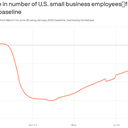The numbers behind the jobs numbers don't look so hot

Published Date: 7/1/2020
Source: axios.com
Reproduced from Homebase; Chart: Axios VisualsSome private data the White House closely monitors has been pointing to an economic recovery that’s plateauing — and that could bolster the case for more stimulus this summer.Driving the news: June's unemployment rate will be released tomorrow morning, but the official jobs numbers are practically dated the moment they flash on financial terminals. The White House watches other private data to get an earlier sense of what's happening — and that data suggests the recovery may be cooling off.Between the lines: Tomorrow's jobs numbers represent a snapshot of the labor market for the week of June 7-13. The headline number — the unemployment rate — will help frame the political discussion for the rest of summer about how much more the federal government should spend to offset the devastating economic consequences of the coronavirus. To get a more technicolor — and timelier — view of what’s actually happening with the economy, the Council of Economic Advisers also relies on troves of big data, shared by credit card companies, tech payment firms and start-ups that normally sell their geospatial data to monitor foot traffic to hedge funds. Details: A data feed from a tech company called Homebase, which manages digital timecards for 100,000 small businesses, is flashing yellow.Fewer employees worked in the last week of June than the rest of the month, suggesting that forthcoming jobless rate could be too low. "While we may be celebrating a positive report on Thursday, we should be mindful of what the most current data shows us,” said Ray Sandza, Homebase’s vice president for data and analytics. “And it doesn't look good."Why it matters: As the White House considers the size and scope of what's needed in a Phase 4 stimulus package, officials are drawing on private data that's highly relevant to a pandemic-induced recession. “In addition to closely monitoring all government data, we rely on a host of private data sources to provide a real-time snapshot of our nation’s economic recovery,” said Tyler Goodspeed, a CEA member and economic scholar.“When it comes to providing the most relevant and timely economic analysis to the President of the United States, the Council of Economic Advisers uses every tool available.”The big picture: Economists have yet to build a machine that could gaze back in time to count the number of imploded small business or collapsed industries. But the smartphones in our purses and pockets — linked to satellites in space — do leave a digital trail that give economists and policy makers more visibility than they have ever had before. The White House looks at aggregated and anonymized data from SafeGraph, which maps some 45 million cellphone locations to more than 5,000 businesses. SafeGraph’s mobility tracker shows that foot traffic to businesses slowed down at the end of last week. Flashback: Since the last stimulus bill was signed into law on April 24, White House officials have adopted a wait-and-see approach, pausing to assess the effects of the some $2.5 trillion that's been shoveled out of the door. That puts the data in the driver's seat. The bigger the downturn, the bigger the stimulus package they're likely to support.In late May, Senate Majority Leader Mitch McConnell told the president in the Oval Office that he wants to keep the price tag for the next package below $1 trillion, Axios reported.White House officials have been coy about how much a Phase 4 bill will cost, though they suggested they won't support anything as large as a $3 trillion proposal from House Democrats.What's next: The technology available to economists in this recession will allow them to test new theories and responses with fresher data.A new paper by National Bureau of Economic Research touts a platform that “tracks economic activity at a granular level in real time using anonymized data from private companies.”A posting by the St. Louis Fed looked at Homebase’s May numbers and how they correlated to the 13.3% unemployment rate, which traditional models flubbed.The bottom line: Economists have always had to navigate the road ahead with an eye in the rearview mirror.A combination of geospatial data, online payments and payroll processing may give them better sensors at the front of the car. But some potholes will be impossible to avoid.